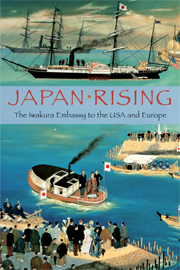Book contents
- Frontmatter
- Contents
- Introduction by Ian Nish
- Note on the Text
- VOLUME I THE UNITED STATES OF AMERICA
- VOLUME II BRITAIN
- 21 A Survey of Britain
- 22 A Survey of London
- 23 A Record of London, 1
- 24 A Record of London, 2
- 25 A Record of London, 3
- 26 A Record of Liverpool, 1
- 27 A Record of Liverpool, 2
- 28 A Record of Manchester, 1
- 29 A Record of Manchester, 2
- 30 A Record of Glasgow
- 31 A Record of Edinburgh
- 32 A Tour of the Highlands
- 33 A Record of Newcastle, 1
- 34 A Record of Newcastle, 2
- 35 A Record of Bradford
- 36 A Record of Sheffield
- 37 A Record of Staffordshire and Warwickshire
- 38 A Record of Birmingham
- 39 A Record of Cheshire
- 40 A Record of London, 4
- VOLUME III CONTINENTAL EUROPE, 1
- VOLUME IV CONTINENTAL EUROPE, 2
- VOLUME V CONTINENTAL EUROPE, 3; AND THE VOYAGE HOME
- Index
28 - A Record of Manchester, 1
Published online by Cambridge University Press: 04 August 2010
- Frontmatter
- Contents
- Introduction by Ian Nish
- Note on the Text
- VOLUME I THE UNITED STATES OF AMERICA
- VOLUME II BRITAIN
- 21 A Survey of Britain
- 22 A Survey of London
- 23 A Record of London, 1
- 24 A Record of London, 2
- 25 A Record of London, 3
- 26 A Record of Liverpool, 1
- 27 A Record of Liverpool, 2
- 28 A Record of Manchester, 1
- 29 A Record of Manchester, 2
- 30 A Record of Glasgow
- 31 A Record of Edinburgh
- 32 A Tour of the Highlands
- 33 A Record of Newcastle, 1
- 34 A Record of Newcastle, 2
- 35 A Record of Bradford
- 36 A Record of Sheffield
- 37 A Record of Staffordshire and Warwickshire
- 38 A Record of Birmingham
- 39 A Record of Cheshire
- 40 A Record of London, 4
- VOLUME III CONTINENTAL EUROPE, 1
- VOLUME IV CONTINENTAL EUROPE, 2
- VOLUME V CONTINENTAL EUROPE, 3; AND THE VOYAGE HOME
- Index
Summary
October 4th, 1872. Rain.
At nine o'clock in the morning we left Liverpool to travel east to Manchester. The railway line which joins these two cities, some thirty and a half miles in length, is the progenitor of all the world's railways. In 1825 Mr. Stephenson had proposed for the first time that iron rails should be laid on roads and carriages drawn along them using steam-power. After arguing this case in all quarters he eventually formed a company and obtained the permission of Parliament to proceed. Construction of the line was completed, and trains began to run on it in 1830.
The town of St. Helens is also in Lancashire, about twelve miles east of Liverpool. In 1869 a group of wealthy men from London and Manchester had formed a company and set up a factory there, at a cost of £100,000, to manufacture plate-glass. Today we broke our journey at St. Helens in order to inspect the factory. We were met by the chairman and other members of the firm, who showed us first the workshop where the ingredients of the glass were mixed. Here, steam-powered machinery was used to crush flint into coarse fragments. This material was then further pulverised, using a machine which consisted of three hard grindstones revolving in a huge iron pan. Below this machine, one bag of lime, two bags of pulverised flint and one bag of soda were mixed together.
- Type
- Chapter
- Information
- Japan RisingThe Iwakura Embassy to the USA and Europe, pp. 146 - 150Publisher: Cambridge University PressPrint publication year: 2009



